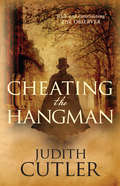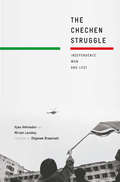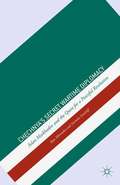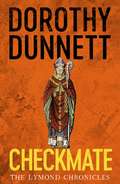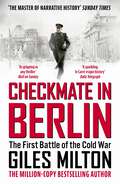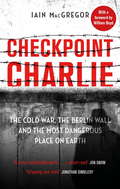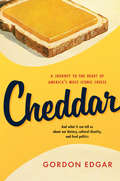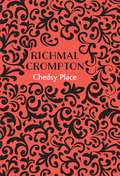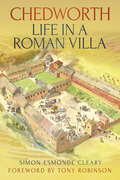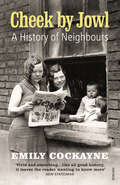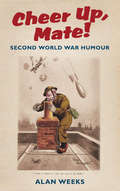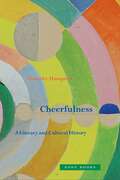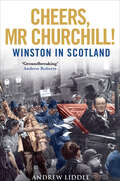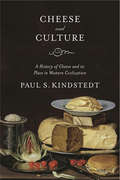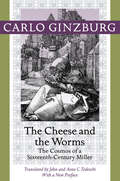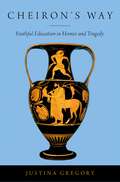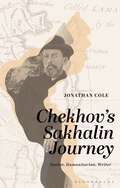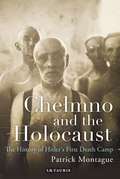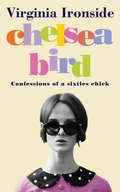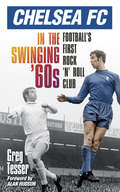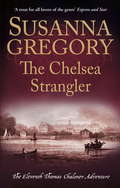- Table View
- List View
Cheating the Hangman (Tobias Campion #3)
by Judith CutlerA fork of lightning and a crash of thunder herald the completion of a heinous crime. In woodland belonging to the eccentric Lord Wychbold, a body has been crucified on a tree. On Easter Day, the Reverend Tobias Campion returns from morning service at St Luke’s and discovers the corpse, already beginning to putrefy. A crown of thorns frames his face, bludgeoned beyond recognition, and a loincloth preserves what is left of his modesty.The victim will not rise again; though the well-concealed secrets of the village will have to, if the perpetrators are to be found. After a post-mortem examination fails to identify the victim, Tobias and his old friend, Dr Hansard, pledge to uncover the truth. Forced to question the gentry as well as the local parishioners, the pair hear whispers of Satanism, of unsavoury pasts and sinister obsessions. Before long, an attempt is made to silence their enquiries into the murder; Tobias, injured but no less determined, realises he must be close to the truth if someone wants him dead. Faced with hostility and resentment from the villagers, Tobias needs to unearth their dark secrets to bring the murderer to light.
The Chechen Struggle: Independence Won and Lost
by I. Akhmadov M. LanskoyTold from the perspective of its former Foreign minister, this is a uniquely candid account of Chechnya's struggle for independence and its two wars against Russia which will revise our understanding of the conflict and explain how it continues. Features new insights, intimate portraits of key personalities and a foreword by Zbigniew Brzezinski.
Chechnya's Secret Wartime Diplomacy: Aslan Maskhadov and the Quest for a Peaceful Resolution
by I. Akhmadov N. DaniloffThis volume makes available transcripts and commentary from the secret correspondence between former Chechen foreign minister Ilyas Akhmatov and Chechen President Aslan Maskhadov. This correspondence provides revelatory insights into both men's attempts to secure Western support for a peaceful transition to an independent Chechnya.
Checkmate: The Lymond Chronicles Book Six (The Lymond Chronicles #6)
by Dorothy DunnettBefore George R. R. Martin there was Dorothy Dunnett . . . THE PERFECT GIFT for fans of A Game of Thrones.'She is a brilliant story teller, The Lymond Chronicles will keep you reading late into the night, desperate to know the fate of the characters you have come to care deeply about.' The Times Literary SupplementCheckmate is the sixth and final book in the series -----------------------------'If they place the sun in my right hand and the moon in my left and ask me to give up my mission, I will not give it up until the truth prevails or I myself perish in the attempt . . .'It is 1557 and legendary Scottish warrior Francis Crawford of Lymond is once more in France. There he is leading an army to rout the hated English from Calais. Yet while Lymond seeks victory on the battlefield he is haunted by his troubled past - chiefly the truth about his origins and his marriage (in name only) to young Englishwoman Philippa Somerville. As the French offer him a way out of his marriage and his wife appears in France on a mission of her own, the final moves are made in a great game that has been playing out over an extraordinary decade of war, love and struggle - bringing the Lymond Chronicles to a spellbinding close.'A masterpiece of historical fiction' Washington Post'Melodrama of the most magnificent kind' The Guardian
Checkmate in Berlin: The Cold War Showdown that Shaped the Modern World
by Giles Milton'Brilliantly recapturing the febrile atmosphere of Berlin in the first four years after the Second World War, Giles Milton reminds us what an excellent story-teller he is' - Andrew Roberts, author of Churchill: Walking with DestinyBerlin was in ruins when Soviet forces fought their way towards the Reichstag in the spring of 1945. Streets were choked with rubble, power supplies severed and the population close to starvation. The arrival of the Soviet army heralded yet greater terrors: the city's civilians were to suffer rape, looting and horrific violence. Worse still, they faced a future with neither certainty nor hope.Berlin's fate had been sealed four months earlier at the Yalta Conference. The city, along with the rest of Germany, was to be carved up between the victorious powers - British, American, French and Soviet. On paper, it seemed a pragmatic solution; in reality, it fired the starting gun for the Cold War. As soon as the four powers were no longer united by the common purpose of defeating Germany, they reverted to their pre-war hostility and suspicion. Rival systems, rival ideologies and rival personalities ensured that Berlin became an explosive battleground. The ruins of this once-great city were soon awash with spies, gangsters and black-marketeers, all of whom sought to profit from the disarray. For the next four years, a handful of charismatic but flawed individuals - British, American and Soviet - fought an intensely personal battle over the future of Germany, Europe and the entire free world.CHECKMATE IN BERLIN tells this exhilarating, high-stakes tale of grit, skullduggery, and raw power. From the high politics of Yalta to the desperate scramble to break the Soviet stranglehold of Berlin with the greatest aerial operation in history, this is the epic story of the first battle of the Cold War and how it shaped the modern world.
Checkpoint Charlie: The Cold War, the Berlin Wall and the Most Dangerous Place on Earth
by Iain MacGregor'With a gripping narrative and vivid interviews with those on all sides whose lives were directly affected by that grim symbol of the East-West divide that poisoned Europe for almost half a century, [MacGregor] has made an important contribution to the history of our times' Jonathan Dimbleby'Captures brilliantly and comprehensively both the danger and exhilaration that I and other reporters, soldiers, and people experienced intersecting with the wall - a must-read for anyone who wants to understand the Europe we have inherited' Jon SnowA powerful, fascinating, and ground-breaking history of Checkpoint Charlie, the legendary and most important military gate on the border of East and West Berlin where the United States and her allies confronted the USSR during the Cold War.As the thirtieth anniversary of the fall of the Berlin Wall approaches in 2019, Iain MacGregor captures the mistrust, oppression, paranoia, and fear that gripped the city throughout this period. Checkpoint Charlie is about the nerve-wracking confrontation between the West and the Soviet Union that contains never-before-heard interviews with the men who built and dismantled the Wall; lovers who crossed it; relatives and friends who lost family trying to escape over it; German, British, French, and Russian soldiers who guarded its checkpoints; CIA, MI6 and Stasi operatives who oversaw secret operations across its borders; politicians whose ambitions shaped it; journalists who recorded its story; and many more whose living memories contributed to the full story of Checkpoint Charlie. A brilliant work of historical journalism, Checkpoint Charlie is an invaluable record of this period.
Cheddar: A Journey to the Heart of America’s Most Iconic Cheese
by Gordon EdgarOne of the oldest, most ubiquitous, and beloved cheeses in the world, the history of cheddar is a fascinating one. Over the years it has been transformed, from a painstakingly handmade wheel to a rindless, mass-produced block, to a liquefied and emulsified plastic mass untouched by human hands. The Henry Fordism of cheddar production in many ways anticipated the advent of industrial agriculture. They don’t call it “American Cheese” for nothing. Cheddar is one man’s picaresque journey to find out what a familiar food can tell us about ourselves. Cheddar may be appreciated in almost all American homes, but the advocates of the traditional wheel versus the processed slice often have very different ideas about food. Since cheddar—with its diversity of manufacturing processes and tastes—is such a large umbrella, it is the perfect food through which to discuss many big food issues that face our society. More than that, though, cheddar actually holds a key to understanding not only issues surrounding food politics, but also some of the ways we think of our cultural identity. Cheddar, and its offshoots, has something to tell us about this country: the way people rally to certain cheddars but not others; the way they extol or denounce the way others eat it; the role of the commodification of a once-artisan cheese and the effect that has on rural communities. The fact that cheddar is so common that it is often taken for granted means that examining it can lead us to the discovery of usually unspoken truths. Author Gordon Edgar (Cheesemonger: A Life on the Wedge) is well equipped to take readers on a tour through the world of cheddar. For more than fifteen years he has worked as an iconoclastic cheesemonger in San Francisco, but his sharp talent for observation and social critique were honed long before then, in the world of ’zines, punk rock, and progressive politics. His fresh perspectives on such a seemingly common topic are as thought provoking as they are entertaining.
Chedsy Place
by Richmal CromptonBringing together a memorable cast of characters, Chedsy Place is a warm and witty novel, filled with the humour, piercing observation and remarkable characterization that makes Richmal Crompton one of the world's best-loved writers.When Richard Beaton inherits Chedsy Place, he feels nostalgic as he returns to his beloved family home. For him it is locked in the past – a place of warm childhood memories – and he cannot afford to keep it. But for his wife, Celia, walking round the grand house sparks the kernel of an idea: to restore it to its former glory by opening its doors once more for Christmas – only this time, to paying guests.Horrified by the idea, Robert watches as the guests arrive from far and wide: the domineering Judith Kimball with her shy secretary Sidney Lattimer, and the chauffeur, who takes a shine to Sidney; the Paynter family with their excitable twin daughters, Cicely and Angela; Miss Nettleton, who travels indomitably about the British Isles seeing the sights; Mrs Stephenson-Pollitt, who retires 'into the silence' each afternoon to seek communion with the spirits, and her nephew, Brian, who is destined for the clergy but must battle with his conscience when he meets Angela. As the guests settle in for Christmas, Robert knows that Chedsy Place will never be the same again . . .
Chedworth: Life In A Roman Villa
by Simon Esmonde ClearyChedworth is one of the few Roman villas in Britain whose remains are open to the public, and this book seeks to explain what these remains mean. The fourth century in Britain was a ‘golden age’ and at the time the Cotswolds were the richest area of Roman Britain. The wealthy owners of a villa such as Chedworth felt themselves part of an imperial Roman aristocracy. This is expressed at the villa in the layout of the buildings, rooms for receiving guests and for grand dining, the provision of baths, and the use of mosaics. The villa would also have housed the wife, family and household of the owner and been the centre of an agricultural estate. In the nineteenth century Chedworth was rediscovered, and part of the villa’s tale is the way in which it was viewed by a nineteenth-century Cotswold landowner, Lord Eldon, and then its current owners, the National Trust.
Cheek by Jowl: A History of Neighbours
by Emily CockayneAlmost everyone has a neighbour. Neighbours can enrich or ruin our lives. They fascinate and worry us in equal measure. Soap operas watched by millions play with every lurid permutation of relationships in fictional neighbourhoods. Disputes over gigantic Leylandii and noise nuisance turn nasty and fill newspaper columns. These stories have a rich history - as long as we have lived in shelters, we have had neighbours. Emily Cockayne traces the story of the British neighbour through nine centuries - spanning Medieval, Tudor and Victorian periods, two world wars and up to today's modern, virtual world. Cheek by Jowl is social history at its most colourful and compelling and puts the people back in the houses and the houses back on the streets.
Cheer Up, Mate!: Second World War Humour
by Alan WeeksCheer Up, Mate! is a compilation of comical tales and anecdotes from World War Two. Between 1939 and 1945 the world witnessed what is generally agreed to be the most horrific war in history. Millions died and millions more were physically or psychologically wounded by the conflict. Yet amidst the pain and devastation, people were not only able to survive, they also managed to maintain a sense of humour. For some, it was precisely this ability to laugh at their misfortunes (and those of the other side) that enabled them to solider on. This was especially true of the British, a nation whose reaction to more or less anything, up to and including someone’s house being bombed to rubble, tended to be, ‘never mind, have a cup of tea’. In this collection of stories, which covers the armed forces and civilians from both sides, Alan Weeks demonstrates how humour can survive even in the most unlikely of circumstances.
Cheerfulness: A Literary and Cultural History
by Timothy HamptonA timely story of a forgotten emotionCheerfulness: A Literary and Cultural History tells a new story about the cultural imagination of the West wherein cheerfulness — a momentary uptick in emotional energy, a temporary lightening of spirit — functions as a crucial theme in literary, philosophical, and artistic creations from early modern to contemporary times. In dazzling interpretations of Shakespeare and Montaigne, Hume, Austen and Emerson, Dickens, Nietzsche, and Louis Armstrong, Hampton explores the philosophical construal of cheerfulness — as a theme in Protestant theology, a focus of medical writing, a topic in Enlightenment psychology, and a category of modern aesthetics. In a conclusion on cheerfulness in pandemic days, Hampton stresses the importance of lightness of mind under the pressure of catastrophe. A history of the emotional life of European and American cultures, a breathtaking exploration of the intersections of culture, literature, and psychology, Cheerfulness challenges the dominant narrative of Western aesthetics as a story of melancholy, mourning, tragedy, and trauma. Hampton captures the many appearances of this fleeting and powerfully transformative emotion whose historical and literary trajectory has never before been systematically traced.
Cheerfulness: A Literary and Cultural History
by Timothy HamptonA timely story of a forgotten emotionCheerfulness: A Literary and Cultural History tells a new story about the cultural imagination of the West wherein cheerfulness — a momentary uptick in emotional energy, a temporary lightening of spirit — functions as a crucial theme in literary, philosophical, and artistic creations from early modern to contemporary times. In dazzling interpretations of Shakespeare and Montaigne, Hume, Austen and Emerson, Dickens, Nietzsche, and Louis Armstrong, Hampton explores the philosophical construal of cheerfulness — as a theme in Protestant theology, a focus of medical writing, a topic in Enlightenment psychology, and a category of modern aesthetics. In a conclusion on cheerfulness in pandemic days, Hampton stresses the importance of lightness of mind under the pressure of catastrophe. A history of the emotional life of European and American cultures, a breathtaking exploration of the intersections of culture, literature, and psychology, Cheerfulness challenges the dominant narrative of Western aesthetics as a story of melancholy, mourning, tragedy, and trauma. Hampton captures the many appearances of this fleeting and powerfully transformative emotion whose historical and literary trajectory has never before been systematically traced.
Cheers, Mr Churchill!: Winston in Scotland
by Andrew LiddleIn 1922 Winston Churchill prepared to defend his parliamentary seat of Dundee in the General Election. He had represented the city since 1908, enjoyed a majority of more than 15,000 and, after five previous victories, confidently described it as a ‘life seat’. But one man had other ideas, and Churchill was in for the fight of his life. This is the story of how god-fearing teetotaller Edwin Scrymgeour fought and won an election against Britain’s most famous politician. It begins with their first electoral contest in 1908 and follows their political sparring the next 15 years until Scrymgeour’s eventual victory in 1922, when he became the only prohibitionist ever elected to the House of Commons. As well as vividly bringing to life an extraordinary personal and political rivalry, the book also explores for the first time Churchill’s controversial relationship with Scotland, including his attitude to devolution.
Cheese and Culture: A History of Cheese and its Place in Western Civilization
by Paul KindstedtBehind every traditional type of cheese there is a fascinating story. By examining the role of the cheesemaker throughout world history and by understanding a few basic principles of cheese science and technology, we can see how different cheeses have been shaped by and tailored to their surrounding environment, as well as defined by their social and cultural context. Cheese and Culture endeavors to advance our appreciation of cheese origins by viewing human history through the eyes of a cheese scientist. There is also a larger story to be told, a grand narrative that binds all cheeses together into a single history that started with the discovery of cheese making and that is still unfolding to this day. This book reconstructs that 9000-year story based on the often fragmentary information that we have available. Cheese and Culture embarks on a journey that begins in the Neolithic Age and winds its way through the ensuing centuries to the present. This tour through cheese history intersects with some of the pivotal periods in human prehistory and ancient, classical, medieval, renaissance, and modern history that have shaped western civilization, for these periods also shaped the lives of cheesemakers and the diverse cheeses that they developed. The book offers a useful lens through which to view our twenty-first century attitudes toward cheese that we have inherited from our past, and our attitudes about the food system more broadly. This refreshingly original book will appeal to anyone who loves history, food, and especially good cheese.
The Cheese and the Worms: The Cosmos of a Sixteenth-Century Miller
by Carlo GinzburgThe Cheese and the Worms is an incisive study of popular culture in the sixteenth century as seen through the eyes of one man, the miller known as Menocchio, who was accused of heresy during the Inquisition and sentenced to death. Carlo Ginzburg uses the trial records to illustrate the religious and social conflicts of the society Menocchio lived in. For a common miller, Menocchio was surprisingly literate. In his trial testimony he made references to more than a dozen books, including the Bible, Boccaccio's Decameron, Mandeville's Travels, and a "mysterious" book that may have been the Koran. And what he read he recast in terms familiar to him, as in his own version of the creation: "All was chaos, that is earth, air, water, and fire were mixed together; and of that bulk a mass formed—just as cheese is made out of milk—and worms appeared in it, and these were the angels."Ginzburg’s influential book has been widely regarded as an early example of the analytic, case-oriented approach known as microhistory. In a thoughtful new preface, Ginzburg offers his own corollary to Menocchio’s story as he considers the discrepancy between the intentions of the writer and what gets written. The Italian miller’s story and Ginzburg’s work continue to resonate with modern readers because they focus on how oral and written culture are inextricably linked. Menocchio’s 500-year-old challenge to authority remains evocative and vital today.
The Cheese and the Worms: The Cosmos of a Sixteenth-Century Miller
by Carlo GinzburgThe Cheese and the Worms is an incisive study of popular culture in the sixteenth century as seen through the eyes of one man, the miller known as Menocchio, who was accused of heresy during the Inquisition and sentenced to death. Carlo Ginzburg uses the trial records to illustrate the religious and social conflicts of the society Menocchio lived in. For a common miller, Menocchio was surprisingly literate. In his trial testimony he made references to more than a dozen books, including the Bible, Boccaccio's Decameron, Mandeville's Travels, and a "mysterious" book that may have been the Koran. And what he read he recast in terms familiar to him, as in his own version of the creation: "All was chaos, that is earth, air, water, and fire were mixed together; and of that bulk a mass formedâ€�just as cheese is made out of milkâ€�and worms appeared in it, and these were the angels."Ginzburg’s influential book has been widely regarded as an early example of the analytic, case-oriented approach known as microhistory. In a thoughtful new preface, Ginzburg offers his own corollary to Menocchio’s story as he considers the discrepancy between the intentions of the writer and what gets written. The Italian miller’s story and Ginzburg’s work continue to resonate with modern readers because they focus on how oral and written culture are inextricably linked. Menocchio’s 500-year-old challenge to authority remains evocative and vital today.
Cheiron's Way: Youthful Education in Homer and Tragedy
by Justina GregoryThis book studies the social and ethical formation of youthful figures in Homer, Sophocles, and Euripides. Every fictional character comes with a past attached, a presumed personal history that is both implicit and explicit; for the youthful heroes and heroines of epic and tragedy, early education figures significantly in that past. Cheiron's Way takes as its point of departure the words of Homer's Phoenix to Achilles, who claims, "I made you the man you are" as he pleads with his former pupil to let go of his anger. The book begins by exploring topics relevant to heroic and tragic education: age classes, rites of passage, verbal modes of instruction, social conditioning, mentoring, peer role models, and the controversial balance between nature and nurture. It introduces the first teacher in the Greek tradition, Cheiron the centaur, who founded a school for young heroes in his Thessalian cave and instructed Achilles, Jason, and others with mixed success. Next it turns to the Iliadic Achilles, who achieves maturity by way of successive crises-a crisis of disillusionment with the assumptions that shaped his heroic education, followed by a crisis of empathy for his adversary-and who becomes an influential prototype for tragedy. Examination of the Odyssey suggests that while Odysseus received a normative heroic upbringing and Nausicaa internalizes social expectations for young women, Telemachus is more of an outlier. In tragic representations of education Sophocles' Ajax and Neoptolemus replicate the Achillean pattern only partially and unsuccessfully, as does Euripides' Hippolytus; only Achilles and Iphigenia in Euripides' Iphigenia in Aulis achieve an emotional maturity commensurate with the Iliadic Achilles'. Yet all these texts confirm, as elegantly argued in this book, the perennial lure, despite uncertain results, of the educational enterprise for communities, students, and teachers.
Cheiron's Way: Youthful Education in Homer and Tragedy
by Justina GregoryThis book studies the social and ethical formation of youthful figures in Homer, Sophocles, and Euripides. Every fictional character comes with a past attached, a presumed personal history that is both implicit and explicit; for the youthful heroes and heroines of epic and tragedy, early education figures significantly in that past. Cheiron's Way takes as its point of departure the words of Homer's Phoenix to Achilles, who claims, "I made you the man you are" as he pleads with his former pupil to let go of his anger. The book begins by exploring topics relevant to heroic and tragic education: age classes, rites of passage, verbal modes of instruction, social conditioning, mentoring, peer role models, and the controversial balance between nature and nurture. It introduces the first teacher in the Greek tradition, Cheiron the centaur, who founded a school for young heroes in his Thessalian cave and instructed Achilles, Jason, and others with mixed success. Next it turns to the Iliadic Achilles, who achieves maturity by way of successive crises-a crisis of disillusionment with the assumptions that shaped his heroic education, followed by a crisis of empathy for his adversary-and who becomes an influential prototype for tragedy. Examination of the Odyssey suggests that while Odysseus received a normative heroic upbringing and Nausicaa internalizes social expectations for young women, Telemachus is more of an outlier. In tragic representations of education Sophocles' Ajax and Neoptolemus replicate the Achillean pattern only partially and unsuccessfully, as does Euripides' Hippolytus; only Achilles and Iphigenia in Euripides' Iphigenia in Aulis achieve an emotional maturity commensurate with the Iliadic Achilles'. Yet all these texts confirm, as elegantly argued in this book, the perennial lure, despite uncertain results, of the educational enterprise for communities, students, and teachers.
Chekhov’s Sakhalin Journey: Doctor, Humanitarian, Writer
by Jonathan ColeChekhov often said that 'I am a doctor by trade and sometimes I do literary work in my free time', a surprising claim, given his status as a giant of 20th century drama. This literary-biographical study uncovers new sides to him, as both a medical professional and humanitarian, and tells the story of Chekhov's trip to Sakhalin Island in the harsh wastes of Siberia.Anton Chekhov practiced medicine for most of his life and engaged in humanitarian work which took him away from writing for months. He placed one such trip though, across the unforgiving terrain of Siberia to write about the penal island of Sakhalin, above all others. Chekhov's Sakhalin Journey, written by a neuroscientist and practicing clinician, uses this trip and Chekhov's own account of it to shed light on hitherto overlooked aspects of his life. In doing so, it shows that to understand the man we need his medicine as well as his literature, and we need to assess his life from his perspective as well as ours.
Chekhov’s Sakhalin Journey: Doctor, Humanitarian, Writer
by Jonathan ColeChekhov often said that 'I am a doctor by trade and sometimes I do literary work in my free time', a surprising claim, given his status as a giant of 20th century drama. This literary-biographical study uncovers new sides to him, as both a medical professional and humanitarian, and tells the story of Chekhov's trip to Sakhalin Island in the harsh wastes of Siberia.Anton Chekhov practiced medicine for most of his life and engaged in humanitarian work which took him away from writing for months. He placed one such trip though, across the unforgiving terrain of Siberia to write about the penal island of Sakhalin, above all others. Chekhov's Sakhalin Journey, written by a neuroscientist and practicing clinician, uses this trip and Chekhov's own account of it to shed light on hitherto overlooked aspects of his life. In doing so, it shows that to understand the man we need his medicine as well as his literature, and we need to assess his life from his perspective as well as ours.
Chelmno and the Holocaust: A History of Hitler's First Death Camp (International Library of Twentieth Century History)
by Patrick MontagueAs the first extermination camp established by the Nazi regime and the prototype of the single-purpose death camps of Treblinka, SobibÓr and Be??ec, the Che?mno death camp stands as a crucial but largely unexplored element of the Holocaust. This book is the first comprehensive work in any language to expose all aspects of the camp's history, organisation and operations and to remedy the dearth of information in the Holocaust literature about Che?mno, the death camp established in a small pastoral village in rural Poland to launch a campaign of mass murder. Che?mno was the first camp to be created with the explicit aim of killing, thus launching the process of industrialised human extermination which the Nazis came to perfect. Patrick Montague chronicles how Che?mno broke the psychological barrier for establishing an extermination camp, which quickly became a template for the Nazis' 'Final Solution'. He reveals events leading to the establishment of the camp, how the mobile killing squad employed the world's first gas van to terminate the lives of mentally-ill patients, and the assembly-line procedure employed in the camp to commit genocide on the Jewish population. Despite the vast body of literature on the Holocaust, the story of Che?mno has been largely overlooked by historians. This book provides the first single-volume history of the camp and its handful of survivors. Based on over 20 years of thorough research, Che?mno and the Holocaust contains previously-unpublished first-hand accounts and photographs. It is a vital contribution to a neglected but critically important chapter in the history of the Holocaust.
Chelsea Bird
by Virginia IronsideThe debut novel of acclaimed writer Virginia Ironside, author of No, I Don't Want to join a Bookclub, originally published in 1964, when she was aged just twenty. London, 1960s. A cultural revolution is taking place. Young people are finally being seen as a force to be reckoned with. But for eighteen-year-old art student Harriet and her Chelsea friends, this amounts to one thing: being'In'. The King's Road swarms with people wanting to see and be seen; upper-class boys with faux cockney accents party with models, beatniks and photographers; teddy boys are good people to nod to in the street; transport caffs are the must-go places for food, and black men have suddenly become the people to know. Through Harriet's eyes, Virginia Ironside paints a witty, tongue-in-cheek portrait of life in 1960's London that will strike a nostalgic chord with all those who were there, and make all those who weren't wish they had been.
Chelsea FC in the Swinging '60s: Football's First Rock 'n' Roll Club
by Greg TesserThey say if you remember the Swinging '60s, you weren't there. And surely no other football club encapsulated that momentus era of change more than Chelsea. As Britain’s youngest football agent, Greg Tesser lived the 1960's dream. As an eighteen-year-old publicist he helped launch the careers of the likes of Eric Clapton and Georgie Fame, before promoting the King of Stamford Bridge himself, the legendary Peter Osgood. It was all showbiz glamour down the Fulham Road in those halcyon, hedonistic years, with Hollywood stars Steve McQueen and Raquel Welch choosing to worship at the shrine of Ossie and co. Football become fashionable with all the Beautiful People - Greg and Charlie Cooke even wrote for Vogue! - QPR legend Rodney Marsh modelled for upmarket glossies, and Ossie morphed into a true '60s icon. A first FA Cup, a first European trophy, all Chelsea fans, indeed all fans of football, will enjoy this journey down memory lane when soccer swung and it was hip to kick a ball.
The Chelsea Strangler: The Eleventh Thomas Chaloner Adventure (Adventures of Thomas Chaloner)
by Susanna GregoryThe eleventh adventure in the Thomas Chaloner series.1665. A city ridden by plague. A vicious killer on the loose. In the sapping summer heat of 1665 there is little celebration in London of the naval victory at the Battle of Lowestoft. The King, his retinue and anyone with sufficient means has fled the plague-ridden city, its half-deserted streets echoing to the sound of bells tolling the mounting number of deaths. Those who remain clutch doubtful potions to ward off the relentless disease and dart nervously past shuttered buildings, watchful for the thieves who risk their lives to plunder what has been left behind.At Chelsea, a rural backwater by the river, with fine mansions leased to minor members of the Court avoiding the capital, there are more immediate concerns: the government has commandeered the theological college to house Dutch prisoners of war and there are daily rumours that those sailors are on the brink of escaping. Moreover, a vicious strangler is stalking the neighbourhood.Thomas Chaloner is sent to investigate the murder of the first victim, an inmate of a private sanatorium known as Gorges. There have been thefts there as well, but the few facts he gleans from inmates and staff are contradictory and elusive. He realises, though, that Gorges has stronger links to the prison than just proximity, and that the influx of strangers offers plenty of camouflage for a killer - a killer who has no compunction about turning on those determined to stop his murderous rampage.'Pungent with historical detail' (Irish Times)'A richly imagined world of colourful medieval society and irresistible monkish sleuthing' (Good Book Guide) 'Corpses a-plenty, exciting action sequences and a satisfying ending' (Mystery People)
